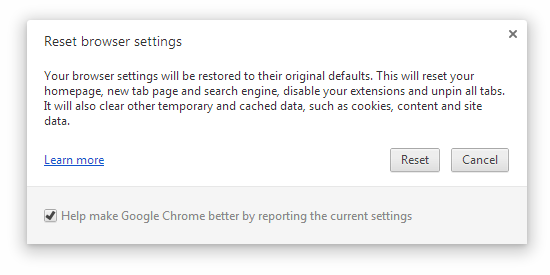The latest stable version of Google Chrome 29 includes a new feature – a reset button that lets user revert their browser to its original state. Using the reset button will strip all user customization out of the browser, delete cookies, forget web history and more. The Chrome team offers this option to use when rogue third-party programs make unwanted changes the browser such as install additional extensions and toolbars or a different search engine. Resetting your browser settings will reset the unwanted changes caused by installing other programs. However, your saved bookmarks and passwords will remain intact.
To reset Chrome’s settings:
- Click the Chrome menu
 on the browser toolbar, and select Settings.
on the browser toolbar, and select Settings. - Browse to the bottom of the Settings page and click Show advanced settings and find the "Reset browser settings” section.
- Click Reset browser settings.

- In the dialog that appears, click Reset.

Resetting your browser settings will impact the settings below:
- Default search engine and saved search engines will be reset and to their original defaults.
- Homepage button will be hidden and the URL that you previously set will be removed.
- Default startup tabs will be cleared. The browser will show a new tab when you startup or continue where you left off if you're on a Chromebook.
- New Tab page will be empty unless you have a version of Chrome with an extension that controls it. In that case your page may be preserved.
- Pinned tabs will be unpinned.
- Content settings will be cleared and reset to their installation defaults.
- Cookies and site data will be cleared.
- Extensions and themes will be disabled, but not removed.

Great tutorial. I am having some problem with Google chrome for last few days. Now I can reset my browser settings.
ReplyDeleteThank you. Very useful.
ReplyDeleteI read your blog pretty frequently. You are doing a very good job. Thanks again. :)